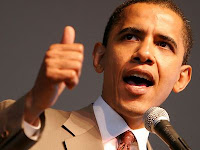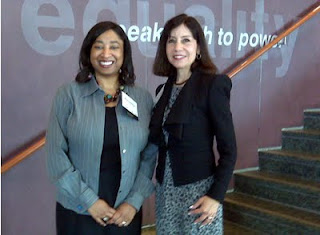 On Friday, November 19th, I was on a panel at the NYC National Speakers Association meeting. The panelists included, Don Gabor, Ann Fry, Diane DiResta, Audrey Smaltz, and Richard Marker. Bob Frare served as the emcee. Each presenter told their story and shared their business models to a packed room held at the NY Bar Association. Most speakers shared that they hadn't planned to be professional speakers but rather fell into it.
On Friday, November 19th, I was on a panel at the NYC National Speakers Association meeting. The panelists included, Don Gabor, Ann Fry, Diane DiResta, Audrey Smaltz, and Richard Marker. Bob Frare served as the emcee. Each presenter told their story and shared their business models to a packed room held at the NY Bar Association. Most speakers shared that they hadn't planned to be professional speakers but rather fell into it.
Here is an overview of the basic speaking business models:
1. Freelance subcontractor. This is where a speaker is hired to do an existing program designed by training companies or other speakers. The advantage is the training company does the marketing and the speaker is paid for delivery. My friend calls this "Show up and throw up." You don't need to be an expert but you must have excellent platform skills and a knowledge of the subject matter.
2. Corporate training model. The speaker delivers his/her own material developed for a particular audience. The advantage is the fees are higher and you own the account. You can also penetrate deeper into a company for more business. Companies continually need to train their workforce and will look for outside experts and consultants to improve performance.
3. Keynote or motivational speaker. This kind of speaker targets the association and corporate market and is generally speaking to large groups. They speak at a lot of conferences and conventions and must have an inspiring message and or a deep level of expertise. Keynote speakers command the highest fees but the downside is they are always looking for the next gig. A convention will not hire the same keynoter for two consecutive years. They often partner with speakers bureaus to book business . The life of a keynoter is to be a road warrior.
4. Product sales model or BOR (back- of- the- room sales). Presenters speak for the purpose of selling products. They either stage their own public seminars and events or speak at conferences. This also can be a lucrative model but the speaker must be able to create products that people want and most importantly, be able to sell from the platform. Selling products from the back -of- the -room is challenging and this model is recommended only for those who have excellent selling skills and can move a crowd to action. It requires getting in front of large groups, transporting products, and having a merchant account.
A subset of BOR is internet sales. Some speakers direct the audience to their websites and sell hard copies and digital products. Other speakers have morphed into primary internet businesses and deliver their message through teleclasses and webinars.
5. Enterprise model. This kind of speaker owns a bonafide business and manages employees. They may own a restaurant, a real estate company, a training company or other enterprise which they can sell. The bulk of their income is derived from the business and speaking is yet another but not the sole source of their income. This is often the most lucrative model because the speaker does not have to trade time for money. Employees or freelancers deliver the product or service. The speaker is positioned as an expert about the business or industry and may speak on business or motivational topics.
When choosing a business model, the main message from the panelists was play to your strengths.
The smartest speakers combine multiple streams of income.


 Marketers, Take Note: Passion Sells
Marketers, Take Note: Passion Sells
 Jeannette Paladino, author of the blog,
Jeannette Paladino, author of the blog, 



 The other day I was on my way to Hilton Head South Carolina.
I boarded the airline which was on time. I sat back in my seat awaiting the usual safety drill. The attendant ended the announcement with "This is a no smoking no complaining flight. If you complain you'll be the entertainment - outside gone with the wind."
The other day I was on my way to Hilton Head South Carolina.
I boarded the airline which was on time. I sat back in my seat awaiting the usual safety drill. The attendant ended the announcement with "This is a no smoking no complaining flight. If you complain you'll be the entertainment - outside gone with the wind." There was a popular song years ago that went " Who let the dogs out?" And that's a question that's apropos this week in the media. The answer is President Obama let the dogs out in his recent speech in Milwaukee. Alluding to his opponents he said, 'They're talking about me like a dog." What does this tell us? Language reflects thought. While some studies state that words are only 7 per cent of the message, words are powerful. They give us insight into what the speaker believes and feels. In this case, Obama is saying he feels like a victim. The key is the wording "They're talking about ME". It's something that is happening to him. It's not the language of leadership. There is a difference between being genuine and appearing weak.
Former Mayor Giuliani showed genuine sadness during the bombing of the World Trade Center but he never spoke like a victim.
There was a popular song years ago that went " Who let the dogs out?" And that's a question that's apropos this week in the media. The answer is President Obama let the dogs out in his recent speech in Milwaukee. Alluding to his opponents he said, 'They're talking about me like a dog." What does this tell us? Language reflects thought. While some studies state that words are only 7 per cent of the message, words are powerful. They give us insight into what the speaker believes and feels. In this case, Obama is saying he feels like a victim. The key is the wording "They're talking about ME". It's something that is happening to him. It's not the language of leadership. There is a difference between being genuine and appearing weak.
Former Mayor Giuliani showed genuine sadness during the bombing of the World Trade Center but he never spoke like a victim.

 For years I've talked about the power of three's. I advise my clients to present 3 agenda items, 3 main points, and 3 benefits. People remember things in three's.
For years I've talked about the power of three's. I advise my clients to present 3 agenda items, 3 main points, and 3 benefits. People remember things in three's.
